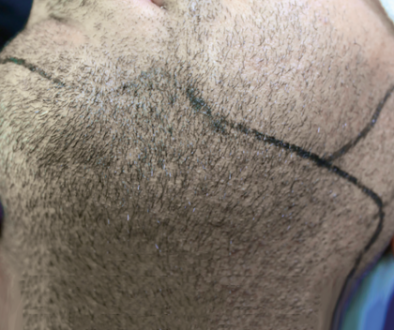Today’s Hair Restoration Choices: Follicular Unit Extraction (FUE) Versus Strip Hair Transplant Surgery
In this article, recommended hair restoration surgeon Dr. Parsa Mohebi shares his expert knowledge comparing follicular unit extraction (FUE) to strip hair transplants:
 Modern hair transplants have come a long way from the plugs and mini-grafts that rendered a very artificial look to the fine results we have today. Follicular unit transplantation has two surgical procedures. These procedures differ in the manner in which the donor hair or better said the donor hair follicles are extracted. These follicular units or micro grafts are removed in their natural unit arrangement and allow the hair restoration surgeon to artfully transplant hair to the bald recipient areas of a patient. The two methods are called Strip Hair Transplant Surgery and Follicular Unit Extraction (FUE) Procedure.
Modern hair transplants have come a long way from the plugs and mini-grafts that rendered a very artificial look to the fine results we have today. Follicular unit transplantation has two surgical procedures. These procedures differ in the manner in which the donor hair or better said the donor hair follicles are extracted. These follicular units or micro grafts are removed in their natural unit arrangement and allow the hair restoration surgeon to artfully transplant hair to the bald recipient areas of a patient. The two methods are called Strip Hair Transplant Surgery and Follicular Unit Extraction (FUE) Procedure.
FUE hair transplant surgery is performed by removing individual follicular units one at a time. This can be performed through manual extraction, automated methods or programmed robotic devices. FUE hair transplantation is a solution that many hair loss sufferers choose. When there is minimum baldness or scar revision, this type of hair transplant makes a lot of sense. When patients absolutely cannot accept the scarring that is necessary with a strip hair transplant surgery, then FUE is again the best option of FUT hair restoration. FUE is a good alternative for individuals that suffer from significant pain; or patients that experienced discomfort or other donor complications with a previous strip hair transplant surgery. FUE is also advantageous for those patients with a depleted donor area for which removing more hair through strip method is impossible.
Both of these hair restoration procedures have strong merit and application for hair loss sufferers. They are the most highly successful methods of hair restoration for both men and women.
The advent of new technologies and surgical techniques allow surgeons to be more precise and efficient with these hair transplant procedures. In this article we will review the advantages of each of these methods and point out certain circumstances that might make one procedure preferable over the other for some patients.
The Benefits of FUT Strip Hair Transplants
- Allows the surgeon to maximize the number of grafts that could be harvested in one session. Strip surgery can allow for the transplanting of over 3500 grafts.
- Strip procedure allows the surgical team to harvest and process the grafts under microscopes, minimizing the level of their transection (damaging hair follicles).
- Patients with large balding recipient areas are serviced better from the high graft volume available through a strip hair transplant procedure.
- Usually the duration of the surgery is considerably shorter than a comparable FUE surgery. This aids many patients’ comfort levels during surgery, in some instances, an important consideration.
- The high number of donor graft availability directly reduces cost and makes the surgery more affordable to the patient.
The Benefits of FUE Hair Transplants
Patients who receive a hair transplant with a strip method will have a linear scar on the donor area. The donor scar might be minimized by some surgical techniques such as trichophytic closure, but it can never be completely eliminated. FUE hair transplant procedures offer unique advantages for various patient circumstances.
- Visibility of the scar is very minimal or non-existent with a FUE transplant. FUE can leave a tiny spot that may represent lack of hair in the area or some de-pigmentation as a small spot which is lighter in close examination of scalp.
- Most people can easily clip their hair short or even shave their head after a FUE procedure. Microscopic scars or hypo-pigmentation can occur, but they are generally scattered and are not grossly detectable in most patients even with a shaved head.
- Pain and discomfort after FUE transplants are very minimal and most patients do not require any pain killers after hair transplantation.
- FUE transplant may allow the surgeon to harvest hair from almost any part of skin. This allows the surgeon to remove hair from the areas that are not regularly included in a strip procedure such as temples, beard or body hair.
- FUE can also be used to minimize the contrast between the areas with high hair density and the balding areas. For example if we are restoring hair in a scalp scar we not only need to add hair to the scar, but we need to minimize the contrast between the scar and surrounding areas.
Establishing realistic expectations and discussing your best options with your hair transplant surgeon is very important. It is in the patient’s best interest to give consideration to the expertise of the doctor when making the final choice of the type of hair restoration surgery.
Parsa Mohebi, MD
Medical Director
US Hair Restoration
Los Angeles, California, USA
—-
David (TakingThePlunge)
Editorial Assistant and Forum Co-Moderator for the Hair Transplant Network, the Coalition Hair Loss Learning Center, and the Hair Loss Q & A Blog.
To share ideas with other hair loss sufferers visit the hair loss forum and social community
Get Proven Treatments at the Best Prices by visiting our new online hair loss treatment shop.
Watch hair transplant videos on YouTube
Technorati Tags: hair transplants, Follicular unit transplantation, follicular units, hair restoration, bald, Hair Transplant, Follicular Unit Extraction, FUE, hair transplantation, hair loss, baldness, FUT, balding, trichophytic closure



